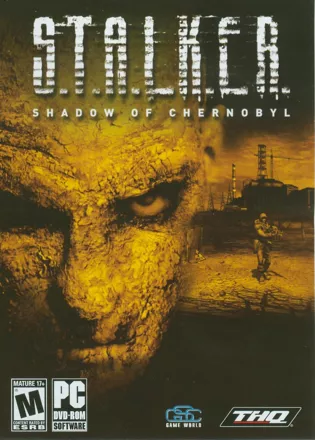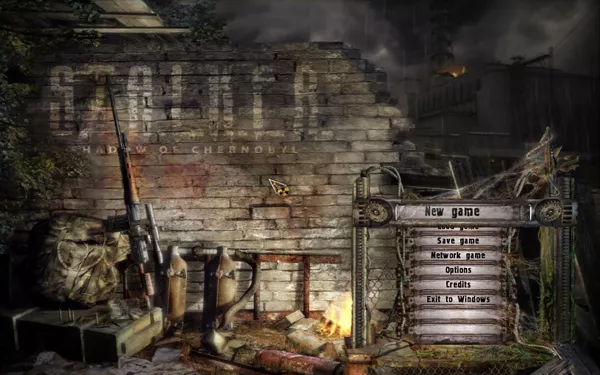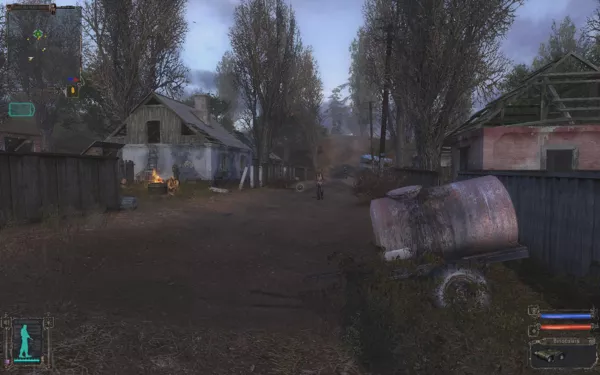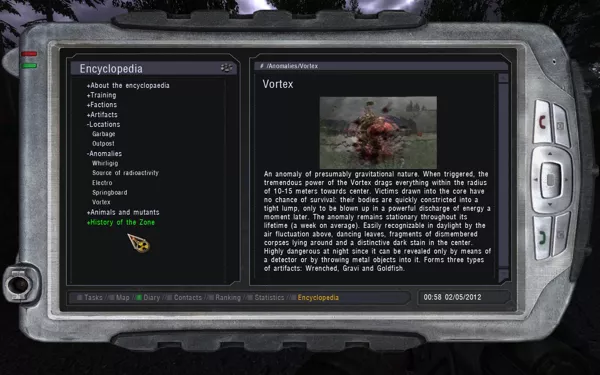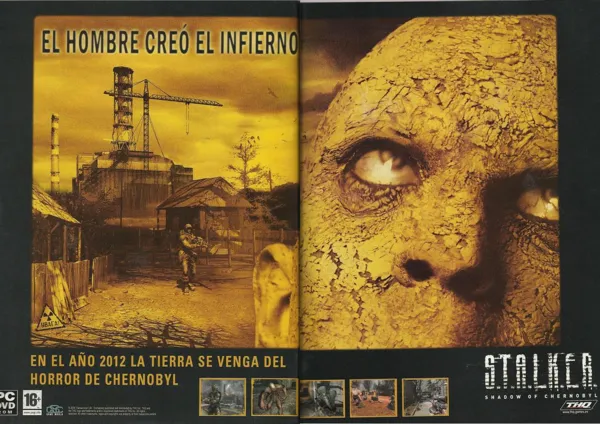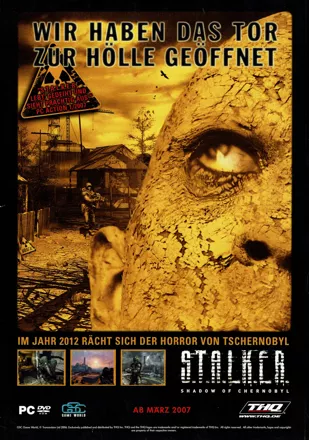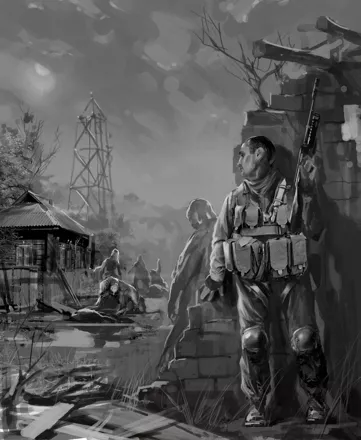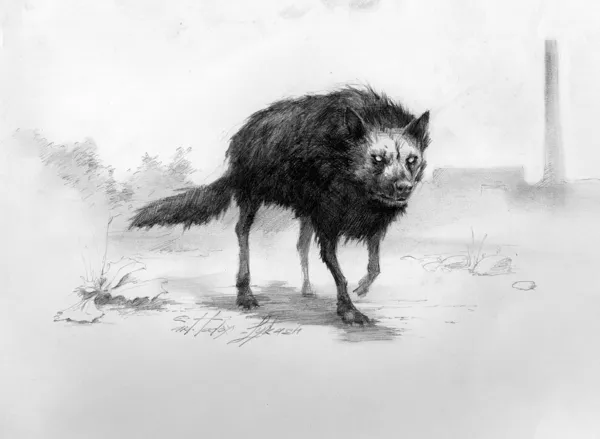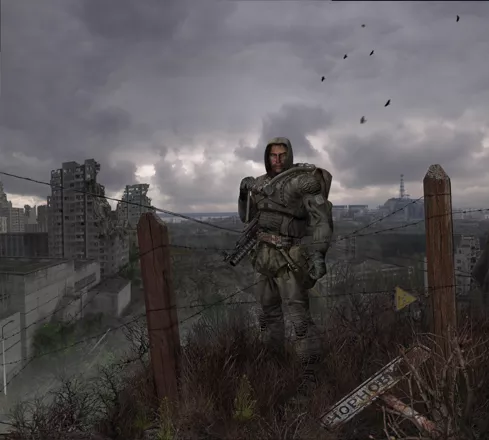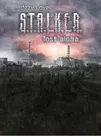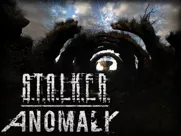S.T.A.L.K.E.R.: Shadow of Chernobyl
Description official descriptions
The Ukrainian town of Chernobyl was the site of a severe nuclear accident in 1986. In an alternate timeline, following attempts to repopulate the area, another unexpected accident occurred twenty years later. By the year 2012 the area, which was dubbed "Zone", has become hazardous with mutated animals, bandits, and mysterious anomalies. These anomalies differ in their effects, but they all have one thing in common - they are deadly. Despite that, the Zone attracts scientists, explorers and scavengers (known as "stalkers") hunting for valuable artifacts. Military organizations have been formed, fighting for dominance in the Zone.
The player controls a stalker who has lost his memory in an accident. After being rescued by another stalker, he discovers himself in a village located on the outskirts of the Zone, with only a single clue: he has a note in his PDA telling him to kill an unknown person with the nickname "Strelok".
S.T.A.L.K.E.R.: Shadow of Chernobyl is inspired by the science fiction novel Picnic on the Roadside (1977) by the Soviet Russian authors, the brothers Arkadi and Boris Strugatsky. The game is an open-ended first-person shooter featuring a thirty square kilometer playing area which the player is free to explore. There are also many characters the protagonist can communicate with; in this sense the game has similarities to RPGs, although there are no attributes or skills to improve. The protagonist may also develop relations with NPCs. Helping a faction will boost his reputation with it, which may result in better items for purchase or information, while attacking a member of said faction will ruin his reputation and prompt other members to attack him. Along with the main quest, the player can also complete side quests, some of which have time limits.
The player has to carefully manage the protagonist's inventory, not only because there is a carrying capacity, but also because weapons and armor degrade as they are used. The player can also use artifacts, which can be usually found near anomalies, to his benefit. Artifacts offer different kinds of bonuses, but often have negative side effects: for instance, an artifact could improve the hero's bullet resistance but also increase his radiation level.
The game features ragdoll physics, destructible surroundings, HDR lightning, dynamic weather, day and night cycles, and multiplayer for up to 32 players.
Spellings
- 迷失地带 - Simplified Chinese spelling
Groups +
- 3D Engine: X-Ray
- Covermount: Level (Romania)
- Gameplay feature: Arena fighting
- Gameplay feature: Armor / weapon deterioration
- Gameplay feature: Burden / Encumbrance
- Gameplay feature: Hunger / Thirst
- Gameplay feature: Multiple endings
- Gameplay feature: Radiation / radioactive poisoning
- Games referenced in movies
- Green Pepper releases
- Inspiration: Author - Arkadi and Boris Strugatsky
- Inspiration: Literature
- Physics Engine: Open Dynamics Engine (ODE)
- S.T.A.L.K.E.R. series
- Scripting language: Lua
- Setting: 2010s
- Setting: Chernobyl Exclusion Zone
- Setting: Country - Ukraine
- Setting: Future now past
Screenshots
Promos
Videos
Add Trailer or Gameplay Video +1 point
See any errors or missing info for this game?
You can submit a correction, contribute trivia, add to a game group, add a related site or alternate title.
Credits (Windows version)
237 People (193 developers, 44 thanks) · View all
| Producer |
|
| Project Lead | |
| Lead Designer |
|
| Lead Programmer | |
| Level Design (Art Department) |
|
| Animation (Art Department) | |
| Character models (Art Department) |
|
| [ full credits ] | |
Reviews
Critics
Average score: 81% (based on 57 ratings)
Players
Average score: 4.0 out of 5 (based on 118 ratings with 6 reviews)
[v1.0] I don’t speak Russian, but I speak S.T.A.L.K.E.R.
The Good
Review Version: v1.0
Review Date: July 28, 2009.
Review Length: 10 page(s).
Game Version: v1.0
Tech Specs Used: Intel Core 2 6300 1.86 Ghz CPU, 3 GB Memory, 512 MB NVIDIA GeForce 8500 GT Video Card.
Difficulty Setting Used: Master.
Finished: Yes, 4 out of (rumor has it) 7 possible endings:
[1] I want the zone to disappear; [2] I want to be rich; [3] Join the C-Conscious; [4] Destroy the C-Conscious.
Last time played: June, 2009.
Preferred main weapon: Vintar BC Silent Sniper Rifle.
Preferred side arm: Big Ben (Special).
Preferred artifact: Mama’s Beads (5% bulletproof cap).
Faction supported: Tried Freedom; Freedom and Duty; and finally killed all of them. :)
Favorite Pastime: Blind dog hunting with grenades.
Most feared enemy: Bloodsuckers and anyone with a rocket launcher.
Last or highest statistics: 3486
[Stalkers killed: 2050; Mutants killed: 796; Quests completed: 697]
Foreword
Note: This section may be skipped
First person shooters aren’t really my kind of genre. Despite having periods in my life where one of the best enjoyments before returning to the dorm was having the highest frag kill count at the end of the day, a certain encounter with a “sniper” on multiplayer games who head-shot me with a Desert Eagle pistol from way across the map made me decide that despite his excellent shooting skills, that bloke seriously needs to get a life. Ironic, since I was the one carrying the sniper rifle. :p But more importantly, it seems that I should get a life too. Or so I thought. :)
Frankly, if I knew what this game was about, I probably wouldn’t get it in the first place. I was “fooled” by the incorrect genre listing on MobyGames that this game is an RPG [correction pending]. So, I bought on the premise that I’m getting a game where I shoot things and develop my character so I can shoot more things. ;p
Apparently S.T.A.L.K.E.R. has reached a certain amount of fame among the would-be-gaming nerds and has even been rumored to be nominated for the most prestigious award in our nerd slang: a classic. Surely such a rumor must be confirmed, if only to dismiss the possibility that this game is yet another marketing hype. But then again, apparently the Russians developed this game, and as far as Eastern Europe (or Asia according to MobyGames, see forums for further details :p) is concerned, they don’t have enough cash flow to fund such a marketing scheme, additionally also not enough dumb adolescents to actually believe it even if they did. :p But then again, the publisher is THQ.
Introduction Guide
Note: This section may also be skipped
If you haven’t played the game and would like to know what it’s about, here a rough summary on what to expect. It’s a First-Person Shooter (FPS), which means that you shoot things from an angle where you cannot see yourself (i.e. First-Person). As a shooter, you can expect certain standard issue weaponry from N.A.T.O. or the Warsaw Pact. Sci-fi weapons exist (though few), and other specially upgraded weapons. Besides shooting things, gameplay usually consists on finishing the main quests, or if the player so chooses, finishing sub-quests (for money, or other item rewards) offered by various Non-Player Characters (NPCs).
And in case you’re wonder, yes, the game has sniper rifles. Whoopee!
The venue is set in the area surrounding the remnants of Chernobyl nuclear power plant in 2011. The plot contains fictional elements of the “what-if” variants in regard to life forms being effected by highly contaminated radioactive waste, to the point where their genes are altered, ultimately turning them into monster-like mutants. It may contain a mild horror theme, but then again, I’m a wuss when it comes to dark corridors with strange noises. :p
The fallout of Chernobyl created a contaminated area immediately quarantined by the military. Anomalies started to emerge in the “Zone,” as well as valuable “artifacts” (items with somewhat magical-like properties, created by the anomalies) sought by the scientific community. Although under quarantine, due to roaming mutants, contamination and whatever secret projects rumored to be conducted in the Zone, many fool-hardy individuals, dubbed as stalkers, brave the zone to obtain these artifacts and sell them to the highest bidder.
Some of these stalkers later became organized into factions. Some factions may be befriended (by completing quests), thus offering additional quests or weapons/items for sale. Each NPC is a member of a particular faction. Killing an NPC will decrease the friendliness of the mentioned faction. Reputation ranges from Friend to Enemy. The “enemy reputation” will warrant members of the faction to shoot you on sight. Excluding the mutants, there are 6 humanoid factions: Loner, Duty, Freedom, Military, Bandits, and Monolith. Loners are technically non-faction. Killing them only makes enemies with their immediate friends within a line of sight. Duty and Freedom offer quests and hate each other’s guts. Befriending one (choice depending) may result in the other faction disliking you. The Military, Bandits and the Monolith factions are always considered enemies, and reputation towards them cannot be improved.
The science fiction (sci-fi) element of the game is anomalies and artifacts. Anomalies are er…anomalies that seem to defy the basic laws of physics. Anomalies usually can be visually seen, for example by a curious gust of wind in a certain spot, which almost looks supernatural in nature. Anomalies are dangerous, different anomalies may inflict different ways of damaging you or enemies/NPCs foolish enough to venture near it. Artifacts are er…artifacts created by anomalies. These artifacts contain properties which will affect your character. Most artifacts have bonuses with a certain price to pay for those bonuses. For example, an artifact when equipped may offer a slight resistance towards bullets, at the cost of radiation building up in you (thus, gradually damaging your health). Another different artifact-type may gradually decrease radiation, but lower your resistance towards fire. Thus, equipping several different artifacts may overall achieve maximum bonus for minimum cost. Rare artifacts however, often have no disadvantages, but rare in this game usually means there is only one or two throughout the entire game. Up to 5 artifacts may be equipped simultaneously.
Other features in the game are hunger daemons (not quite sure if you have to eat, never died of starvation before), inventory weight encumbrance, night/daytime cycling – weather included, one rifle slot plus one sidearm slot, armor, ability to carry bodies (not quite sure what for, but it’s fun regardless), ability to barter and talk with most NPCs, ability to store items, headshot kill, radioactive poisoning, and stamina (cannot run when tired). All of which, if I’m bored enough, will one day have their own MobyGames game group. :)
Endnote, the over-all goal in this game is to discover the mystery behind the Zone (besides shooting everything that moves strangely along the way).
First Impressions
Gloomy. Not really my favorite atmosphere, but then again we are talking about Chernobyl. A cheerful setting at an abandoned nuclear power plant would no doubt be inappropriate of moronic proportions. :)
Despite the grayness of it all, the gloom-atmosphere does indeed capture the imagination for person(s) residing outside the former iron curtain following its collapse. Broken down Soviet machinery, signs of economic recess, and remnants of Cold War weaponry. The only thing missing would be a drunken CIA agent in the background. :p
The beginning intro immediately captures this “idea,” a death truck filled with (obviously) dead bodies. Yep. This doesn’t look good. Especially when you figured out that you’re one of those bodies, though not very dead, despite qualifying as a Russian zombie, malnutrition and all.
So, now you’re in-game. The gloomy main menu itself gives the impression that your idea of a luxury meal is pile of stale canned meat. You’re alive, have amnesia (saw that one coming), and your only clue to your identity is to kill some Russian bloke. Sounds easy enough, how many Russians can there be in Chernobyl anyways? :p
Then it hits you. The music. Melancholy with a capital M. Yikes, if the atmosphere wasn’t depressing enough, the fantastic music would even make the most hardcore Russian zombie cry. Surprisingly, the music is mostly extraordinary every step of the way, especially when someone picks up a guitar and goes acoustic. Not the kind of feature I would expect from an FPS game, but regardless, whoever made those compositions has, without a doubt, great taste. Subjectively speaking of course.
Adventure - Russian-Style
Hello. Why do I have quests? Isn’t this supposed to be an FPS? Interesting. After talking to the first NPC, he offers quests to be completed. Hmm. This game may not turn out to be not-so-stupid after all. A lot of quests, which one to take? Maybe later. Explore first, missions second (except for the main quest). Standard rule in adventure gaming.
So, you’re a S.T.A.L.K.E.R. Not quite sure what that means, but apparently it’s an equivalent to a scavenger. Makes sense. A lot of blokes here. All armed. His shot gun is longer that my pistol. That somewhat wrecks your self-esteem. Oh, well. How do I get out of this run-down village?
Amazing. First thing I noticed in the game when adventuring was the grass. All moving simultaneously as if the wind was blowing fiercely. The graphics throughout the game are surprisingly detailed, although this is more apparent in other areas such as building complexes. Well, at this point of my nagging, I’m sure you’ll get the idea, as far as atmosphere goes, this game has all of my 5 thumbs up. Thus far, you can travel around to most areas to your heart’s leisure. Certain areas are crawling with mutants, most animals are easy to kill; the humanoid versions can get quite nasty. Other places are filled with bandits or soldiers who make the game feel like an FPS again.
Many a non-linear style adventure game allows the player to travel anywhere, anytime, usually unrestricted. S.T.A.L.K.E.R. is partially linear. Although the player can travel to certain areas, there really isn’t any point, as the main plot only develops by finishing assigned main quests. Although it depends on personal taste, I prefer “directed-storytelling” than a free flow story, if only to fully appreciate which direction the story teller wants the player to experience.
Shooting Things
Although the adventuring and quests part of the games, almost make the FPS elements of this game a sub-genre rather than a main-genre, don’t be fooled. The enemy artificial intelligence (AI) is pretty advanced, despite some bugs here and there. The AI pretty much knows how to maneuver and hide, sometimes even flanking. They do make use of obstacles, and usually prioritize (for those with guns) in finding cover rather than other FPS games where the AI just rushes forwards to you guns blazing.
Damage is realistic enough, depending on your armor and the weapon the enemy has, usually can hurt you pretty bad, pretty fast. So the Rambo-style of gameplay for adolescent eggheads by “shoot first”-“shoot fast”-“shoot a lot”-“aim later”, doesn’t really work very well in this game. And that's a good thing.
The Bad
After fully exploring the game, you can tell that this was one ambitious project. As far as the detailed graphics go, you can probably assume that heavy research was conducted for the game to be visually realistic. But as most ambitious projects usually end up in games, more than often, screw-ups do occur when meeting the deadline of not so patient but usually realistic publishers.
However, amazing enough, what blunders the game did have does not warrant any trashing enough to make me go berserk. So, well done, despite minor irritations here in there. A lot of irritations actually, but at least it didn’t make me want to throw out my monitor to the former Soviet Union.
Let’s get irritated.
Sub-Quest Screw-ups
Somewhat figured that this would be problematic. The sub-quests in the game is by far, the most problematic and bug-infested issue in the game. But despite the bugs, there are some features of the quests that are extremely annoying. Sub-quests have a time-limit. Usually 24 hour’s in-game time. Seems like a long while, not so when you’re busy gunning down bandits and soldiers while playing catch with mutant doggies and grenades. Time does fly fast when everywhere you go, you leave a trail of empty bullet shells, so when suddenly you realize you have only 3 hours left to finish the mission, and you haven’t even started, well, why use a time limit anyway? I’ll get it done, when it’s done. Having a “failed mission” in my statistic report does not bode well for my insides.
Other sub-quests are forced upon you without your consent. When entering certain areas, these missions require you to fend off attackers. Which is probably fine, but sometimes, to successfully complete the mission, you have to back-track off your intended course. Well, back to the majority of buggy screw-ups:
- Some sub-quests cannot be completed regardless what you do;
- Some sub-quests cannot be completed if you try an alternative method/sequence than the obvious one;
- Some sub-quests seemed to have misplaced their intended objects or persons;
- Some NPCs seem to have forgotten that I just completed the retrieve armor/weapon mission, that they are in possession of that item thus not really retrievable, yet they’re offering it again;
- Some sub-quests require objects that are located in areas that I currently cannot enter. No warning either.
Warning this section may contain possible spoilers! Near the end-game, you finally reach Chernobyl. This is quite odd, since before entering here, there was a minor sequence where you could see this arena-like area swarming with Wild Boar mutants, anomalies, and Monolith snipers. Somehow it got skipped. Dang it. Anyway, the Chernobyl battlefield is the stuff FPS dreams are made of. Obviously, most developers have yet to realize that the most fascinating map is a big wide flat area with various minor obstacles. Not those dark damp confusing passageways…or is that just me? :p So, here we are. Military soldiers everywhere, Monolith disciples armed with snipers and rocket launchers, Military gunships flying around, either shooting you, getting blown to bits by the Monolith, or even more interesting, getting destroyed by anomalies. So what’s the problem? Three things:
-
[1] Point of no return
Well, a warning would be nice. I hate it when developers do that. Especially the first time around, I realized I just ran out of bullets (yikes, and I had 700 to begin with). :p [2] Hey, where are the others?
If everyone is trying to reach the center of the zone, where did all the Loner, Duty, and Freedom stalkers run off to? Now we only the Military and Monolith factions around. Not that I’m really complaining, but I was expecting EVERYONE to be here. [3] Time Limit
I really, really, really hate it when developers do that. It’s me against everyone else (choppers included), I’m a bit busy right now. Can I please kill everyone and everything in sight? I’m having the time of my life here, so why did you developers put in a %!#%!$ time limit here. Gawd, this was a severely disappointing plot design. Did I mention I really hate it when they do that?
Throws a grenade to whomever came up with this stupid plot idea.
Warning this section contains spoilers! Well, depending on your personal choices, it’s more likely you’ll end up with one of the minor Wish Granter endings. The problem with the Wish Granter endings is that you’ll probably have no idea what the overall plot was about in the first place, which obviously will make you feel severely empty with that “huh, that’s it?” sensation and look on your face when you finish the game. Additionally, entering the end-game phase, there’s this creepy Russian (I assume) voice-over in the background repeatedly saying something that sounds like this, though my hearing isn’t as what it used to be (in no particular order): Vaznragav-dyonbudi toyke-agil
Tvai-yat-zeisdis, idi-kamen-nye
Prishsloviene yavizhud tvaize lange
Tvaiyezelangi skor-itsfo-nietze, idi-kamen-nye
Puszagar lasam laviek, idi-kamen-nye
Idi-kamen-nye, tri-abri-tyosh-tosh-toza-sluzh-nuvayez If you don’t understand Russian and additionally as there aren’t any sub-titles to help you out, then it’s basically your closest bet on what to say to Russian chicks. :p At least, dear comrade. Please tell me what idi-kameny-nye means. The most possibly satisfying ending (and takes much longer) is if you refuse to join the C-Conscious. Although the ending still sucks, the game is more satisfying if you are able to see more than 2 ending cut-scenes. Unfortunately, you probably won’t know there are multiple endings to begin with. Last but not Least After killing possibly several hundred stalkers, you have the best rifle around (personal preference), heavy armor, rare artifact, a butt-load full of bullets, and an almost perfect head-shot kill track record; you’re basically a biological Russian assault vehicle. Then you discover something lacking. There aren’t enough people to shoot at. :(
**The Bottom Line**
So, why is S.T.A.L.K.E.R. a classic? Simply because it takes the average FPS genre and pushes it to the next level. And suddenly you find an FPS that isn’t simply just about running around and shooting things. Enjoy your visit as a S.T.A.L.K.E.R.
The intelligent FPS game.
Na zdoróvye!
Windows · by Indra was here (20755) · 2009
The Good
The Graphics: Not spectacular, but the art design stands out and they work hand in hand with other elements to create a visually appealing and surreal setting in the zone.
Sound: The sound will immerse you into the bizarre surroundings of the zone, and will even sometimes go farther than any of the horrific mutants in creating a genuine atmosphere and feel of terror. The strange sounds emanating throughout the zone along with the stark uninviting and harsh wind is guaranteed to keep you on your toes.
Combat: The combat is great, realistic and very involving. It can be tough, but it only helps immerse you further due to the realism and genuine feeling that you have to take care of yourself and survive, using any method possible be it a bigger gun or patching yourself up before the battle.
The Game World: The game world is easily the best part, The Zone is a well defined and scary place, and is wide open for exploration... at your own risk. The game sucked me in more than any other "sandbox" type game, as the complex system of the zone is so well balanced and unique. You will have the desire to explore, but the dangers of the Zone will keep you on edge too.
"Hybrid" gameplay:
Is it a first person shooter with RPG elements? Is it an RPG with guns? It's hard to say. To me, it feels like a cross between a lite-RPG, a military simulator, a horror game, an adventure game, and of course a shooter. This hybrid of gameplay blends seamlessly with the equally unique system of the zone, you will make a name for yourself, affect the world, and truly feel like you are trying to survive from crazed militants and frightening mutants and the deadly "anomalies" that are strewn across the zone.
The Bad
Mediocre Voice Acting: No one really seems to put any effort into their roles, and just grunts out lines. It's also inconsistent, important characters will speak English but others will speak Russian, and sometimes a glitch will cause them to just revert to Russian which can be confusing for someone like me who doesn't speak Russian.
Bugs, Bugs, and More Bugs: The engine needs some serious retooling. There are too many glitches to note, the list I attempted to compile consisted of over 300 giant bugs... and this is after several patches. It also has a strangely steep system requirement due to poor threading of the engine. It's also a bummer to have an intense fight crash on you.
Difficulty: STALKER's difficulty can be daunting at first. I almost wanted to hate the game because I had to do the first mission 20 times on the "Rookie" setting. There is almost no tutorial and you are thrust into the game rather jarringly, so you have to learn the game through lots and LOTS of trial. If you have patience, you will soon adapt to the difficulty and you will adapt to the zone, but the initial difficulty can make the game have a slow and sometimes frustrating start.
Disappointing story: The story had lots of ideas going for it, but it never really went anywhere. It doesn't help that the character you play as has no characteristics at all. The endings are also a disappointment. There are moments that the story is interesting, but usually those moments relate more to new areas of the zone and events in the zone, and less about the characters story. I also felt let down as, while I know this is not a direct adaptation of "The Roadside Picnic" or the film "Stalker," I feel like it could have used the more philosophical elements of those stories to greater effect.
Graphics are as bad as they are good: Like I said, STALKER looks good from the artistic standpoint, and looks very surreal and neat, but when you look at the game from the technical standpoint, its not impressive at all. Animations are stiff, facial expressions sort of jerk around unblinkingly, lighting is slightly off, and some textures are just very low resolution and sometimes jaggy.
The Bottom Line
Stalker is a game that is impossible to describe. The best way to describe it is if you have played the game "Deus Ex;" Imagine Deus Ex, but with a more realistic weapons system, a sandbox world, and mutants. It's similar to that, but even then, it defies categorization. Stalker is one of the most unique games in years, if not ever. It's hard to explain, it's hard to even understand, but it will suck you in and compel you to play through many times over.
If you are open minded, and want a change of pace from other shooters, STALKER will bring you that change and despite its problems, the amazing and memorizing game world will win you over and make up for almost all of the flaws (Except maybe the constant crashes, which usually happen during the best parts). Check out this game if you have not already!
Windows · by Kaddy B. (777) · 2009
The best game ever made, S.T.A.L.K.E.R. sets a new standard in the genre.
The Good
While most first-person shooter games always make promises of realism and immersion, none of them -- not even Half-Life and Deus Ex -- even come close to accurately simulating real life. Of course, this is largely because developers are afraid that making a game "too realistic" will suck the fun out of it. But if developers like GSC Game World can take the time to make it as realistic and fun as possible, squeezing in the details that you'll find in real life, they'll actually end up with an unbelievably great game like S.T.A.L.K.E.R.: Shadow of Chernobyl.
S.T.A.L.K.E.R. is an open-ended game, which means that instead of a linear gameworld where you follow the same path every time, you can freely roam around the gameworld and accept missions from other people that you find. Most of these missions are completely optional. This freedom, coupled with the fact that everything happens in real-time, ensures unparalleled replay value. Further adding to the immersion is the really intense nature of the combat. Since your weapons are inaccurate to start out with, and you don't take much damage before dying, you need to use tactics and stealth to survive against your extremely cunning AI opponents. Whether you're fighting mutant or human enemies, these guys use cover and tactics more efficiently than anyone can ever dream of. They also act differently depending on various attributes, like how hungry they are or even the weather outside! You really feel like you're in an actual gunfight. Heck, you could avoid combat altogether by using stealth tactics to sneak past your enemies...it's all up to you.
Attention to detail is very characteristic of S.T.A.L.K.E.R. A first in the shooter genre is the inclusion of food and sleep. Just like in real life, you'll need to eat food to stay alive, and get sleep in a safe resting spot. Dynamic weather and real-time alternation between day and night settings also help to fool you into thinking that you're truly in the game's alternate reality. S.T.A.L.K.E.R. also corrects the cliché of having to walk over items to pick them up. You press the Use key on items to add them to your inventory, and when you loot a corpse, you're presented with a menu so you can choose which items you want to loot. You're also limited to how much you can carry, and heavier items take up more space in your inventory. While this has been attempted in previous games, players would be frustrated when they had to pick up items in the heat of battle. This isn't an issue here, as you only have to pick up items when you're not in combat.
Just when you thought that S.T.A.L.K.E.R. couldn't get any more immersive, it presents you with photo-realistic graphics using GSC's own X-Ray engine. While the engine doesn't really have any graphical features that we haven't seen before, it more than makes up for this by having the best detail and lighting that you will ever see in any game. As expected, the great graphics come at a cost: even on my high-end PC, the game ran pretty slow unless I toned it down to minimum settings. If you have the rig to play it with the settings turned up, though, you'll constantly be amazed at how lifelike these graphics are. The audio is also spot-on. The weapons sound almost exactly like in real life, adding even more flavor to the combat. Since most of the characters are Ukrainian, they speak in actual Ukrainian accents, which adds to the authenticity of the game. Some characters just speak Ukrainian, so you'll see subtitles to be able to understand what they're saying.
The Bad
You're kidding me, right? This game rocks!
The Bottom Line
Mixing the best elements from games like Half-Life and Deus Ex with brand-new innovations, S.T.A.L.K.E.R. sets a new standard for future games to follow. Forget all those games that guide you along the same path each time. Forget all those games with rough level transitions. Forget all those games where you can snipe with a chaingun. Forget all those games where you don't eat or sleep. S.T.A.L.K.E.R. will become the new obsession of gamers everywhere, and will do to the gaming world what The Wizard of Oz did to movies. My suggestion is to finish every game that you haven't beaten yet, as S.T.A.L.K.E.R. will truly make all your other games lose their luster...
Windows · by Spartan_234 (424) · 2007
Discussion
| Subject | By | Date |
|---|---|---|
| SEVA Suit cosplay | Angel80 | Feb 16, 2015 |
| Kruglov taking radiation measurement bug | Angel80 | Feb 15, 2015 |
| RPG? | Patrick Bregger (301035) | Aug 23, 2013 |
| Patch Guide? | Zovni (10504) | Oct 17, 2011 |
| Essential mods? | Late (77) | Jul 29, 2010 |
Trivia
1001 Video Games
S.T.A.L.K.E.R.: Shadow of Chernobyl appears in the book 1001 Video Games You Must Play Before You Die by General Editor Tony Mott.
PDA
At some point of the game, you find one PDA called "Gordon's PDA". Some people say you find it in some scientist's corpse, but it seems to be more random than that. Reading it, the owner tells how he was first in Black Mesa, then in some Russian town and then here in Ukraine. This is clearly a reference to the Half-Life series and the possibility of that series' protagonist Gordon Freeman visiting the zone as an stalker.
The funny thing is how Freeman looks like a total rookie trying to survive in the Zone, to the point that he even has to trade his crowbar for a can of food. The bottom line comes when you realizes that you have just killed Gordon Freeman (which is why you have his PDA), who hasn't been able to survive to the Zone after all.
References to the game
S.T.A.L.K.E.R.: Shadow of Chernobyl was parodied in an episode of "Die Redaktion" (The Editorial Team), a monthly comedy video produced by the German gaming magazine GameStar. It was published on the DVD of issue 08/2007.
Weapons
The survival knife that the player character (the man known as "Marked One") uses for fighting is almost certainly based on an HB-1-01, manufactured by the Russian company Izhmash. Information also contributed by 88 49, and Patrick Bregger.
Analytics
Upgrade to MobyPro to view research rankings!
Related Sites +
-
The S.T.A.L.K.E.R. wiki
The S.T.A.L.K.E.R. wiki (Game page on the .S.T.A.L.K.E.R. wiki, a Wikipedia style database about the .S.T.A.L.K.E.R. series (English)) -
Wikipedia
Detailed information about the game on Wikipedia
Identifiers +
Contribute
Are you familiar with this game? Help document and preserve this entry in video game history! If your contribution is approved, you will earn points and be credited as a contributor.
Contributors to this Entry
Game added by Mortimer.
Xbox One, Xbox Series, PlayStation 4 added by Plok. OnLive added by firefang9212.
Additional contributors: Sciere, UV, MichaelPalin, Sicarius, lasttoblame, Cantillon, oct, Plok, FatherJack.
Game added March 28, 2007. Last modified March 23, 2024.
